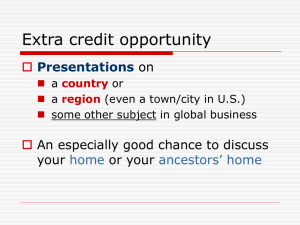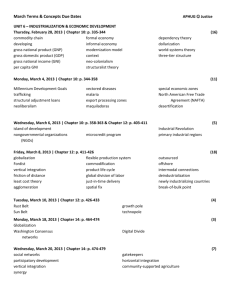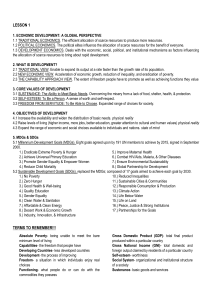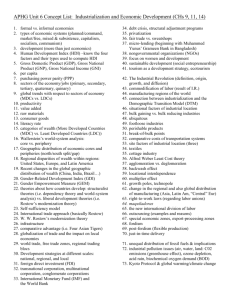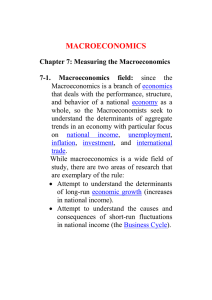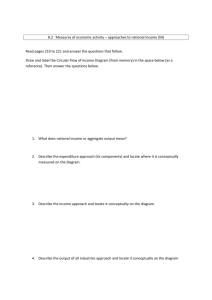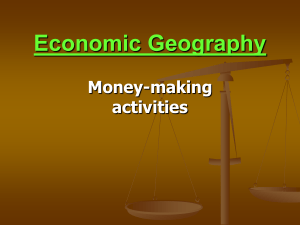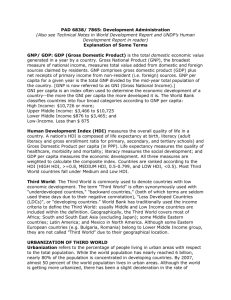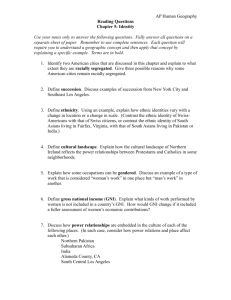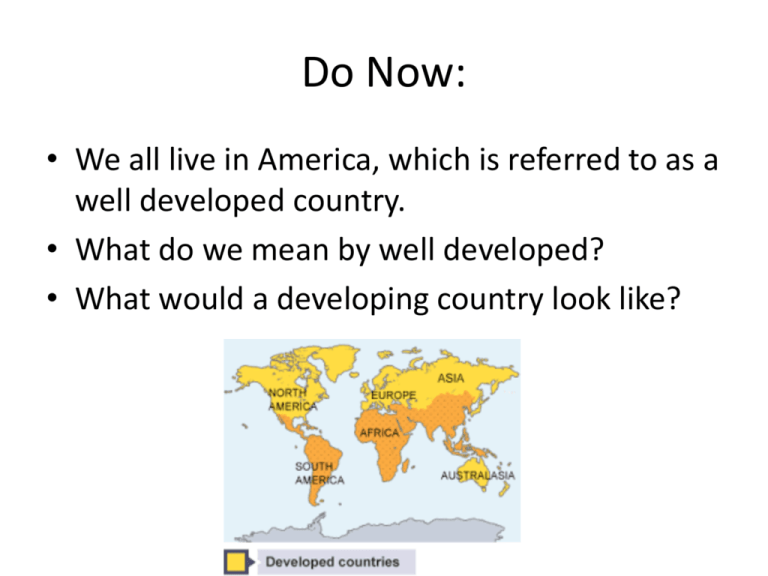
Do Now:
• We all live in America, which is referred to as a
well developed country.
• What do we mean by well developed?
• What would a developing country look like?
Field Note:
Geography, Trade, and Development
“Walking down one of the major
streets of Timbuktu, Mali , I could
hardly believe I was in the
renowned intellectual, spiritual,
and economic center of the
thirteenth to sixteenth centuries.
At that time, the place had a great
reputation for wealth, which
spurred the first European
explorations along the African
coast. What survives is a relatively
impoverished town of some 35,000
people providing central place
functions for the surrounding area
and seeking to attract some tourist
business based on its legendary
name.”
© 2012 John Wiley & Sons, Inc. All rights reserved.
Aim: How is development defined
and measured?
How Is Development Defined
and Measured?
• Wealth does not depend solely on what is
produced; it depends in large part on how and
where it is produced.
• Developing country: is making progress in
technology, production, and socioeconomic wellbeing
• 3 major areas of concern:
1. development in economic welfare,
2. development in technology and production,
3. development in social welfare.
GNP and GDP
GNP (Gross national product)
GDP (Gross domestic product)
• measure of the total
value of the officially
recorded goods and
services produced by
the citizens and
corporations of a
country in a given
year, and includes
things produced both
inside and outside
the country’s
territory.
• which encompasses
only goods and
services produced
within a country
during a given year.
Gross National Income
• Gross national income (GNI): monetary worth of
what is produced within a country plus income
received from investments outside the country minus
income payments to other countries.
• The most common way to standardize GNI data is to
divide it by the population of the country, yielding
the per capita GNI.
• Formal economy: the legal economy that
governments tax and monitor.
• Informal economy: uncounted or illegal economy
that governments do not tax and keep track of.
Gross National Income Limitations
•
•
•
GNI per capita masks extremes in the distribution of
wealth within a country.
GNI per capita measures only outputs (i.e., production).
It does not take into account the nonmonetary costs of
production.
Alternative measures of economic development, ways of
measuring the roles that technology, production,
transportation, and communications play in an
economy.
Gross National Income
• Other analysts focus on social welfare to measure
development dependency ratio: a measure of the
number of dependents, young and old, that each 100
employed people must support.
• A high dependency ratio can result in significant
economic and social strain.
• statistics to measure social welfare:
including literacy rates
infant mortality
life expectancy
caloric intake per person
percentage of family income spent on food
amount of savings per capita.
Guest Field Note:
Sukabumi, West Java
“My own research is based on fieldwork in Indonesia as well as ongoing
engagement with students in the United States. The women pictured here
collaborated with me on a research/activism project for migrant women workers in
Indonesia. The woman on the left (“Rina”) had returned from working in Saudi
Arabia as a domestic worker for two years. She wanted to return to Saudi Arabia
for another contract to earn more money for herself and her family, but she was
concerned about her rights and her safety.” Credit: Rachel Silvey, University of
Toronto
Development Models
• Criticism of the development model:
• It does not take geographical differences
very seriously.
• The conceptualization of development has
a Western bias.
• It does not consider the ability of some
countries to influence what happens in
other countries.
Walt Rostow’s modernization model: assumes that all
countries follow a similar path to development or
modernization, advancing through five stages of
development:
1. The society is traditional, and the dominant activity
is subsistence farming.
2. Preconditions of takeoff: New leadership moves the
country toward greater flexibility, openness, and
diversification.
3. Takeoff: the country experiences something akin to
an Industrial Revolution, and sustained growth
takes hold.
4. Drive to maturity: Technologies diffuse, industrial
specialization occurs, and international trade
expands.
5. High mass consumption: high incomes and
widespread production of many goods and services.
Figure 10.5
Rostow’s Ladder of Development. This ladder assumes that all countries
can reach the same level of development and that all will follow a similar
path. Adapted with permission from: P. J. Taylor. “Understanding Global
Inequalities: A World-Systems Approach,” Geography, 77 (1992): 10–21.
Is the idea of economic development inherently
Western? If the West (North America and
Europe) were not encouraging the “developing
world” to “develop,” how would people in the
regions of the “developing world” think about
their own economies?

